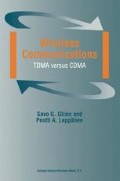Abstract
In order to successfully demodulate a digitally modulated signal, the receiver must first synchronize its oscillators and clocks to the received signal. If direct-sequence spread-spectrum modulation is used, then it is also necessary to synchronize to the code sequence that was used to produce the spectral spreading. Methods used to achieve coarse synchronization to the code sequence, also called acquisition of the code sequence, will be discussed in this chapter. Serial search methods require comparatively little hardware but can take a long time to achieve acquisition. On the other hand, parallel search methods can acquire the code sequence very quickly, but can be somewhat expensive to implement. A survey of some of these basic ideas is presented and some improvements on known methods are suggested.
Access this chapter
Tax calculation will be finalised at checkout
Purchases are for personal use only
Preview
Unable to display preview. Download preview PDF.
References
K. K. Chawla and D. V. Sarwate, “Parallel acquisition of PN sequences in DS/SS systems,” IEEE Transactions on Communications, vol. COM-42, pp. 2155–2164, May 1994.
K. K. Chawla and D. V. Sarwate, “Acquisition of PN sequences in chip synchronous DS/SS systems using a random sequence model and the SPRT,” IEEE Transactions on Communications, vol. COM-42, pp. 2324–2334, June 1994.
M. Cohn and A. Lempel, “On fast M-Sequence transforms,” IEEE Transactions on Information Theory, vol. IT-23, pp. 135–137, January 1977.
C. W. Helstrom, Statistical Theory of Signal Detection, Pergamon Press, 1968.
R. A. Korkosz and D. V. Sarwate, “Serial acquisition of PN sequences in chip asynchronous DS/SS systems,” in Proc. MIL COM Conference, vol. 3, pp. 789–793, October 1993.
R. A. Korkosz, “Serial acquisition of PN sequences in direct-sequence spread-spectrum communication systems,” Ph.D. thesis, Departmen t of Electrical and Computer Engineering, University of Illinois at Urbana-Champaign, Urbana, Illinois, 1994.
R. A. Korkosz and D. V. Sarwate, “Estimation of delay of sgnature sequences in chip asynchronous DS/SS systems,” in IEEE International Conference on Communications Record, vol. 3, pp. 1696–1700, May 1994.
S. Tantaratana and A. W. Lam, “Noncoherent sequential acquisition for DS/SS systems,” in Proceedings of the 29th Annual Allerton Conference on Communication, Control, and Computing, pp. 370–379, October 1991.
S. Tantaratana and A. W. Lam, “Mean acquisition time for noncoherent PN sequence sequential acquisition schemes,” in Proc. MIL COM Conference, vol. 3, pp. 784–788, October 1993.
U. Madhow and M. B. Pursley, “Acquisition in direct-sequence spread-spectrum communication networks: An asymptotic analysis,” IEEE Transactions on Information Theory, vol. 39, pp. 903–912, May 1993.
U. Madhow and M. B. Pursley, “Mathematical modeling and performance analysis for a two-stage acquisition scheme for direct-sequence spread-spectrum CDMA,” IEEE Transactions on Communications, vol. 43, pp. 2511–2520, September 1995.
A. H. Nuttall, “Error probabilities for equicorrelated M-ary signals under phase-coherent and phase-incoherent reception,” IRE Transactions on Information Theory, vol. IT-8, pp. 305–314, July 1962.
R. L. Pickholtz, L. B. Milstein, and D. L. Schilling, “Spread spectrum for mobile communications,” IEEE Transactions on Vehicular Technology, vol. 40, pp. 312–322, May 1991.
R. L. Peterson, R. E. Ziemer, and D. E. Borth, Introduction to Spread Spectrum Communications, Prentice Hall, 1995.
M. B. Pursley, “The role of spread spectrum in packet radio networks,” Proceedings of the IEEE, vol. 75, pp. 116–134, January 1987.
D. V. Sarwate and M. B. Pursley, “Crosscorrelation properties of pseudorandom and related sequences,” Proceeding of the IEEE, vol. 68, pp. 593–619, May 1980.
J. L. Shanks, “Computation of the fast Walsh-Fourier transform” IEEE Transactions on Computers, pp. 457–459, May 1969.
A. M. Slonneger and D. V. Sarwate, “Noncoherent parallel acquisition of PN Sequences in direct-sequence spread-spectrum systems,” Proceedings of the Second IEEE International Symposium on Spread-Spectrum Techniques and Applications, 31–34, November 1992.
E. A. Sourour and S. C. Gupta, “Direct-sequence spread-spectrum parallel acquisition in a fading mobile channel,” IEEE Transactions on Communications, vol. 38, pp. 992–998, July 1990.
M. Srinivasan and D. V. Sarwate, “Parallel acquisition of spreading sequences in DS/SS systems,” Proceedings of the Conference on Information Sciences and Systems, vol. II, pp. 1163–1168, 1994.
M. Srinivasan and D. V. Sarwate, “Noncoherent parallel acquisition of spreading sequences in DS/SS systems,” Proceedings of the Conference on Information Sciences and Systems, vol. II, pp. 858–863, 1996.
M. Srinivasan and D. V. Sarwate, “Simple schemes for parallel acquisition of spreading sequences in DS/SS systems,” IEEE Transactions on Vehicular Technology, vol. 45, pp. 593–598, August 1996.
M. Srinivasan, “Parallel acquisition of spreading sequences in direct-sequence spread-spectrum communication systems,” Ph.D. thesis, Department of Electrical and Computer Engineering, University of Illinois at Urbana-Champaign, Urbana, Illinois, 1996.
G. L. Turin, “The characteristic function of Hermetian quadratic forms in complex normal variables,” Biometrika, vol. 47, pp. 199–201, June 1960.
Rights and permissions
Copyright information
© 1997 Springer Science+Business Media Dordrecht
About this chapter
Cite this chapter
Sarwate, D.V. (1997). Acquisition of Direct-Sequence Spread-Spectrum Signals. In: Wireless Communications. Springer, Boston, MA. https://doi.org/10.1007/978-1-4757-2604-6_6
Download citation
DOI: https://doi.org/10.1007/978-1-4757-2604-6_6
Publisher Name: Springer, Boston, MA
Print ISBN: 978-1-4419-5017-8
Online ISBN: 978-1-4757-2604-6
eBook Packages: Springer Book Archive

